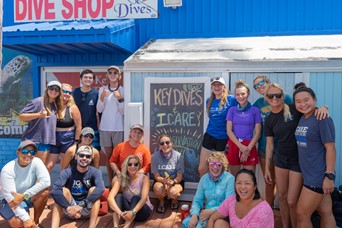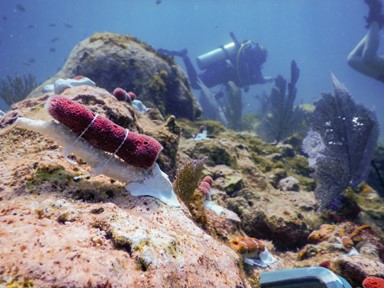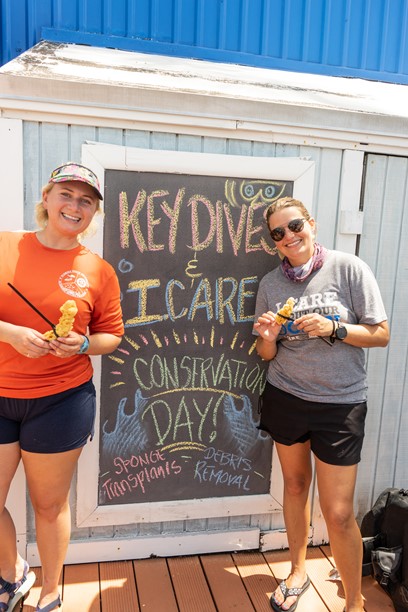 Recently, EcoWatch wrote a spectacular article on Ph.D. candidate, Bobbie Renfro, and her work on sponges in the Florida Keys with the Islamorada Conservation and Restoration Education (I.CARE) organization. Bobbie’s research at FSU revolves around the effects of nutrient enrichment on Caribbean reef sponges, and her expertise and passion for studying these invertebrates has proved invaluable in her ground-breaking work with I.CARE.
Recently, EcoWatch wrote a spectacular article on Ph.D. candidate, Bobbie Renfro, and her work on sponges in the Florida Keys with the Islamorada Conservation and Restoration Education (I.CARE) organization. Bobbie’s research at FSU revolves around the effects of nutrient enrichment on Caribbean reef sponges, and her expertise and passion for studying these invertebrates has proved invaluable in her ground-breaking work with I.CARE.
The Florida Keys host the third largest barrier reef in the world, but what was once a vibrant ecosystem has been decimated by a deadly coral disease, climate change, and poor water quality leaving only 1-2% of the reef in good condition according to some surveys. As part of a $97 million phased project to conserve and restore the coral reefs, the National Oceanic and Atmospheric Association (NOAA) is working to increase coral cover through various methods – growing and gluing coral buds onto the reefs, creating comprehensive coral rescue plans, and evaluating invasive species populations. As restoration work in the Keys expands, a new animal is taking center stage – the humble sea sponge.
 As noted by Bobbie, sponges play a variety of roles in the coral reef ecosystem. Three of these roles are critical ways that sponges help coral reef habitats survive. First, they are the “natural Brita filters” of the reef. They help filter out bacteria-sized plankton and nutrients and they expel clean, clear water. As part of Bobbie’s research, she analyzes and monitors just how much of the harmful nutrients the sponges filter out, which then provides a baseline of the water quality around the reef. Second, sponges are one of the habitat formers of a reef. They provide substrate and habitat for animals, such as brittle stars, to settle on, thus ultimately contributing to the overall function and balance of the ecosystem. Finally, not only are sponges the “glue” that holds the reefs together, they act as a binder for corals to help them survive wave breaks until they permanently settle onto the reef itself.
As noted by Bobbie, sponges play a variety of roles in the coral reef ecosystem. Three of these roles are critical ways that sponges help coral reef habitats survive. First, they are the “natural Brita filters” of the reef. They help filter out bacteria-sized plankton and nutrients and they expel clean, clear water. As part of Bobbie’s research, she analyzes and monitors just how much of the harmful nutrients the sponges filter out, which then provides a baseline of the water quality around the reef. Second, sponges are one of the habitat formers of a reef. They provide substrate and habitat for animals, such as brittle stars, to settle on, thus ultimately contributing to the overall function and balance of the ecosystem. Finally, not only are sponges the “glue” that holds the reefs together, they act as a binder for corals to help them survive wave breaks until they permanently settle onto the reef itself.
Without a doubt, sponges are vital to the survival of coral reefs, so how are we helping to restore them? Bobbie and her team take branching sponges (sponges that often naturally break up into fragments and land in the reefs) and attach them to pieces of dead coral using zip-ties. Then the team scuba dives to the seafloor where they use a marine epoxy to cement these pieces to the reef. As the sponge naturally grows, it becomes “glue” on the reef, overtakes the epoxy, and later, the team dives back into the ocean to cut and remove the plastic zip-ties.
 Bobbie is at the forefront of this intersectional restoration work, and as an advocate for marine science outreach, she has enlisted “citizen divers” to help outplant more of these sponge-coral pieces. This summer, she, FSU Academic Diving program trained undergraduate student Sarah Smith, and the “citizen divers” transplanted 350 sponges that will be monitored monthly. Bobbie will use the findings to continue to apply to grants and other funding opportunities so this project can grow even more. "There are so many people invested in this, and it really is wholistic restoration," Renfro states. "We're trying to save the entire coral reef ecosystem, which includes so much more than just corals."
Bobbie is at the forefront of this intersectional restoration work, and as an advocate for marine science outreach, she has enlisted “citizen divers” to help outplant more of these sponge-coral pieces. This summer, she, FSU Academic Diving program trained undergraduate student Sarah Smith, and the “citizen divers” transplanted 350 sponges that will be monitored monthly. Bobbie will use the findings to continue to apply to grants and other funding opportunities so this project can grow even more. "There are so many people invested in this, and it really is wholistic restoration," Renfro states. "We're trying to save the entire coral reef ecosystem, which includes so much more than just corals."
To learn more about how to support this project, visit the I.CARE website.

